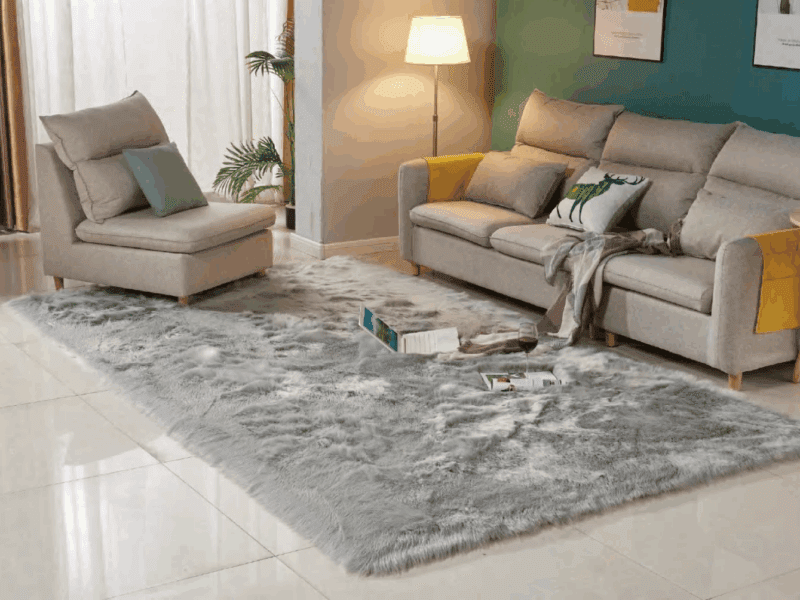
Imagine a perfect get-together with friends: gathering around a low coffee table, sinking into a plush, soft carpet, the casual setting instantly fostering closeness and lively conversation. A great carpet is more than just a floor covering; it’s a foundational element that elevates your home’s comfort and beauty, truly bringing a sense of well-being.
As a manufacturer of carpets and mats, we understand the profound impact a high-quality carpet can have. To help you find the perfect piece for your home, we’ve compiled a detailed guide to the world of carpets, covering classifications based on fiber material, texture, and weaving technique.
A carpet is essentially a floor covering made from natural fibers—such as cotton, linen, wool, silk, or grass fiber—or synthetic (chemical) fibers. These materials are transformed into stunning pieces through various hand or mechanical processes like knotting, tufting, or weaving. Carpets are one of the world’s most enduring and culturally rich forms of decorative art.
I. Classification by Fiber Material
Carpets fibers are primarily divided into two main categories: natural and synthetic.
A. Natural Fibers (Predominantly Wool)
Wool is the classic material for premium carpets. After carding and spinning into yarn, wool is woven into beautiful products.
- Characteristics: Excellent moisture absorption, superior insulation, great elasticity (natural anti-static properties).
- Pros: Can be crafted into high-end goods, soft and luxurious feel.
- Cons: Less wear-resistant, shrinks when wet, susceptible to microbial and insect damage.
- Note: Chinese native sheep wool is prized for its long fiber, high tensile strength, elasticity, and luster, making it a globally recognized top-tier raw material. Some manufacturers blend it with imported wool (e.g., from New Zealand) to combine the strength of native wool with the fineness and luster of imported fibers.
B. Synthetic (Chemical) Fibers (Predominantly Nylon)
Synthetic fibers, mainly derived from petrochemical products, are commonly used for interior carpets.
- Characteristics: High durability, excellent resistance to abrasion and flexing, good resistance to chemicals and microbes. Tends to generate more static electricity.
II. Classification by Carpet Material Type
Beyond just the fiber category, carpets are specifically classified by the composition of their pile.
1. Pure Wool Carpet
Made entirely from sheep’s wool.
- Pros: Soft texture, high tensile strength and elasticity, beautiful patterns, vibrant colors, luxurious feel. Perfect for living rooms and bedrooms in high-end homes.
- Cons: Vulnerable to microbes, moth damage, and moisture. High initial cost and expensive maintenance.
2. Blended Carpet
A mixture of natural wool and a certain percentage of synthetic fibers (often nylon) to enhance performance. Adding about 20% nylon significantly improves wear resistance.
- Pros: Improved resistance to moths, corrosion, and mildew compared to pure wool. Suitable for high-traffic areas in premium homes.
- Cons: The pattern, color, and texture may differ slightly from pure wool, often offering a less luxurious hand-feel.
3. Synthetic Fiber Carpet
Also known as man-made carpets, these are subdivided into Nylon, Polypropylene, Polyester, and Acrylic. Modern weaving technology has made high-quality synthetic carpets that can rival the touch of real wool while avoiding its natural drawbacks.
- (1) Nylon (Polyamide) Carpet: The most common and widely used synthetic carpet. It closely mimics the patterns and colors of pure wool and is generally priced higher than other synthetics.
- Key Feature: Exceptional durability and wear resistance. Overcomes the issues of corrosion and mildew found in pure wool. Nylon 6,6 is structurally denser and offers better elasticity, hardness, feel, and stain resistance than Nylon 6, making it ideal for high-traffic public spaces like offices.
- (2) Polypropylene (PP) Carpet: More affordable than nylon, offering good value.
- Pros: Lightweight, good wear resistance, elastic, high strength, low cost.
- Cons: Highly flammable, posing a fire risk.
- (3) Polyester (PET) Carpet:
- Pros: Excellent heat and sun resistance, good elasticity and abrasion resistance. Does not mildew or attract moths. Good light resistance (second only to acrylic).
- Cons: Difficult to dye, lower moisture absorption, prone to static and dust attraction.
- (4) Acrylic Carpet:
- Pros: Cost-effective, soft, good hand-feel, warm, good elasticity, strong acid resistance. Resistant to mildew, corrosion, and moths.
- Cons: Poor wear resistance, prone to static, attracts dust, poor heat resistance, low moisture absorption, easily pills.
4. Silk Carpet (True Silk Carpet)
These are luxury, high-end floor or wall coverings, traditionally hand-knotted using mulberry or tussah silk threads. They hold significant artistic and collection value due to the craftsmanship involved.
- Pros: High elasticity and toughness, soft luster, excellent water absorption and dryness retention.
- Cons: Limited production, very expensive.
5. Plastic or Rubber Mat (A.K.A. Hydrophobic Mat)
Commonly used for practicality.
- Key Feature: Waterproof, anti-slip, easy to clean.
- Common Use: Doorways of commercial buildings, hotels, homes, bathrooms, and entry halls.
- Cons: High hardness, lacking the soft texture of fabric carpets. Plastic is flammable and releases toxic fumes when burned.
III. Classification by Surface Texture
Carpets can be classified by the structure of their pile surface:
- Loop Pile Carpet: The surface consists of continuous, uniform loops.
- Characteristics: Neat loops, moderate smoothness and hardness, comfortable to walk on, excellent durability, easy to clean. Ideal for areas with high foot traffic. Variations in loop height or partially cut loops can create elegant, subtle patterns.
- Cut Pile Carpet: The loops are cut, creating a tufted surface.
- Characteristics: Fine, soft surface texture. Pile length typically ranges from 5 to 30mm. Shorter pile is more durable and practical but less luxurious. Longer pile is soft, full, elastic, warm, and offers a more opulent, luxurious feel.
IV. Classification by Weaving Process (Craftsmanship)
The manufacturing method is another key differentiator:
- Handmade Carpet: Crafted using superior wool, workers manually knot two loops around every warp thread, resulting in an exquisite and highly durable carpet.
- Machine-Woven Carpet: Includes several mechanical or semi-mechanical types:
- Hand-Tufted Carpet (Gun-Tufted): Produced with simple machinery, offering a relatively robust structure and rich, complex patterns. This is considered semi-mechanical.
- Tufted Carpet: A mechanized process where needles insert pile (loops or cut pile) into a synthetic backing fabric.
- Shaggy Carpet: Characterized by its long, soft pile for exceptional comfort.
In Summary: The classification by weaving process and material type are two independent dimensions. For example, a pure wool carpet can be either hand-knotted or machine-woven. The final production method is chosen based on factors like material, size, budget, and design requirements.
Globally, carpets are highly expressive art forms, often rich in national and ethnic characteristics, though modern designs are also prevalent. Their substantial texture, three-dimensional depth, and elegant appearance make them a fantastic decorative choice. We hope this guide empowers you to select the perfect carpet that brings both comfort and style to your beloved home!

